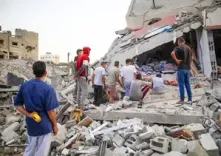Is the ‘Gujarat Model’ Behind PM Modi's Vision for the Ahmedabad High-Speed Rail Project?

Synopsis
Key Takeaways
- The PM's review marks a significant milestone for India's next-gen transport.
- Local industries expect substantial benefits from improved connectivity.
- The corridor will link major cities, enhancing inter-city travel.
- The project emphasizes the government's push for large-scale infrastructure development.
- It positions India among advanced nations with high-speed rail networks.
Surat, Nov 15 (NationPress) Prime Minister Narendra Modi undertook an extensive assessment of the Mumbai-Ahmedabad High-Speed Rail (MAHSR) initiative during his recent visit to Gujarat on Saturday. Residents view this as a pivotal achievement in India's ambition to enhance future transport infrastructure, indicating that it will foster growth and development in the area.
Upon his arrival at Surat International Airport on Saturday morning, the Prime Minister traveled by helicopter to Antroli, where the under-construction Surat Bullet Train Station—a key station within the corridor—is taking form.
During the visit, the Prime Minister evaluated the Surat station—a design influenced by the city's world-famous diamond sector.
A textile entrepreneur, Kaushik Ramanuj, shared with IANS, "We believe that the bullet train will immensely benefit Gujarat, particularly its diamond and textile sectors. Enhanced connectivity to Mumbai is also on the horizon. Following the Prime Minister's visit, it appears we will soon fully leverage the bullet train project."
The corridor is set to link major urban centers including Ahmedabad, Vadodara, Bharuch, Surat, Vapi, Thane, and Mumbai, and is anticipated to reduce travel time between these metros to approximately two hours, greatly improving inter-city transportation.
Another business figure, Hardik Patel, told IANS, "When we refer to PM Modi's vision, we recognize that he has already revolutionized Gujarat during his time here. Today, Gujarat is regarded as a benchmark for India. The bullet train will facilitate easier travel from Ahmedabad to Mumbai, significantly aiding the transportation of goods for the diamond and textile industries in Surat."
Residents also praised the project, stating that the benefits will extend not only to business owners but also to the general populace.
A local expressed to IANS, "PM Modi's visit is expected to benefit traders, residents, and the wider community. His inspection is likely to accelerate progress on the project, allowing people to soon take advantage of its services."
As per the National High-Speed Rail Corporation Ltd. (NHSRCL), over 85% of the corridor—around 465 km—is being developed on elevated viaducts, with 326 km already finalized.
Significant progress has also been made on river crossings, with 17 out of 25 bridges completed. The 47-km Surat–Bilimora section ranks among the most advanced areas, where civil works and track-bed preparations have reached completion.
The Prime Minister's on-site evaluation underscores the government's focus on hastening large-scale, impactful infrastructure projects. Once operational, the MAHSR corridor is poised to revolutionize regional connectivity, stimulate economic growth, and position India among nations with sophisticated high-speed rail systems.









